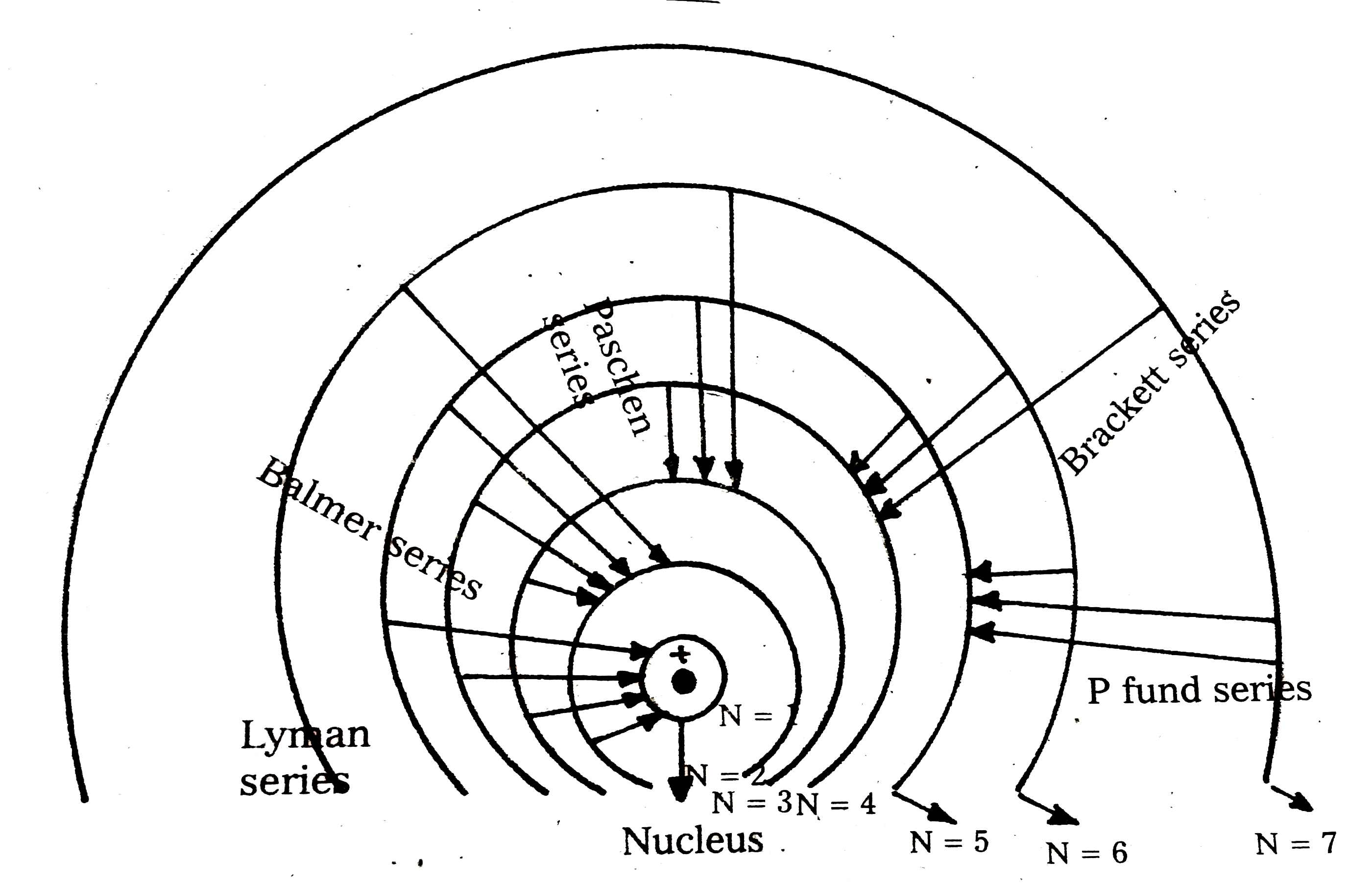Discuss Bohr's theory of the spectrum of hydrogen atom.
1) According to Bohr's model an electron continuous to revolve round the nucleus in fixed, stationary orbits. This is called ground state of the atom In ground state there is no emission of radiation.
2) But when some energy is given to an atom the electron absorbs this energy. This is called excited state of the atom. In this state the electron jumps to the next higher orbit. But it can remain 10−8 sec and it immediatly returns back to its ground state and the balance of the energy is emitted out as a spectral line.
3) According to Bohr's third postulate, the emitted energy is given by E=hv=E2−E1
But E2=−me48ε20h21n2 and
E1=−me48ε20h21n21 (∵Z=1)
∴¯v=1λ=me48ε20ch3[1n211n22]=R[1n21−1n22] [∵v=cλ]
Where R=−me48ε20ch3= Rydberg const.

Hydrogen atom has five series of spectral lines. They are
1. Lyman series : When an electron jumps from the outer orbits to the first orbit, the spectral lines are in the ultra - violet region: Here n1=1,n2=2,3,4,5....
1λ=R[112−1n22]=R[1−1n22]
2) Balmer Series : When an electron jumps from the outer orbits to the second orbit, the spectral lines are in the visible region. Here n1=2,n2=3,4,5.....
1λ=R[122−1n22]
3) Paschen series : When an electron jumps from the outer orbits to the third orbit, the spectral lines are in the near infrared region. Here n1=3,n2=4,5,6....
4) Brackett series : When an electron jumps from outer orbits to the forth orbit, the spectral lines are in the infrared region. Here n1=4,n2=5,6,7....
1λ=R[142−1n22]
5) Pfund series : When an electron jumps from outer orbits to the fifth orbit, the spectral lines are in the far infrared region. Here n1.=5,n2=6,7,8,.....
1λ=R[152−1n22]
Related Playlists
- BOOK - VIKRAM PUBLICATION ( ANDHRA PUBLICATION)CHAPTER - ATOMSEXERCISE - TEXTUAL EXERCISES12videos
ATOMS
- BOOK - VIKRAM PUBLICATION ( ANDHRA PUBLICATION)CHAPTER - ATOMSEXERCISE - ADDITIONAL EXERCISES24videos
ATOMS
- BOOK - VIKRAM PUBLICATION ( ANDHRA PUBLICATION)CHAPTER - ATOMSEXERCISE - short answer question9videos
ATOMS
- BOOK - VIKRAM PUBLICATION ( ANDHRA PUBLICATION)CHAPTER - ANDHRA PRADESH MARCH-2019EXERCISE - SECTION-C3videos
ANDHRA PRADESH MARCH-2019
- BOOK - VIKRAM PUBLICATION ( ANDHRA PUBLICATION)CHAPTER - COMMUNICATION SYSTEMEXERCISE - TEXTUAL EXERCISES8videos
COMMUNICATION SYSTEM
Similar Questions
(a) State the postulates of Bohr's model of hydrogen atom and derive the expression for Bohr radius.
(b) Find the ratio of the longest and the shortest wavelengths amongst the spectral lines of Balmer series in the spectrum of hydrogen atom.View SolutionOn the basis of Bohr.s theory, derive an expression for the radius of the nth orbit of an electron of hydrogen atom.
View SolutionAccording to Bohr's theory of hydrogen atom
View SolutionState the postulates of Bohr's theory of hydrogen atom. Write the necessary equations.
View SolutionAccording to Bohr's theory of the hydrogen atom, the radii of stationary electron orbits are related to the principal quantum number n as :
View SolutionState the postulates of Bohr's theory of hydrogen atom. Write the necessary equations.
View SolutionIn the Bohr's theory of H atom
View SolutionAccording to the Bohr's atomic theory, what will be the energy of hydrogen atom For infinite quantum number number?
View SolutionBohr's atomic theory gave the idea of :
View SolutionBohr's atomic theory gave the idea of :
View Solution

